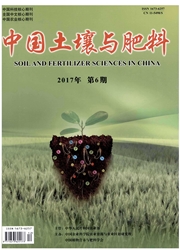

 中文摘要:
中文摘要:
用田间试验方法研究了栽培模式、播种密度和施氮量与小麦(Triticum aestivum L.)子粒中锌、铁、锰、铜含量与携出量的关系。结果表明,施用氮肥显著地提高了子粒产量,5种栽培模式中覆膜栽培表现出较大的增产效应,而增大播种密度在本试验条件下的增产作用较小;在30种处理组合下,4种微量元素在小麦子粒中含量的分布趋势均为铁〉锰〉锌〉铜,表明这些元素的含量分布主要受作物自身遗传性状的控制,而人为的栽培措施的影响是有限的,不同处理组合对子粒中铁、锰和铜的含量均有显著性影响,而对锌含量未表现出明显影响;补灌栽培与覆膜栽培相比,前者能显著提高子粒铜含量,施用N肥条件下,子粒锌、铜含量均显著高于不施N肥;覆膜栽培下铁、锰携出量高于其它4种栽培模式,施用N肥显著提高了小麦子粒中锌、铁、锰、铜携出量。此外,不同栽培模式、播种密度和施氮量下土壤中有效态锌含量的变异幅度极小。
 英文摘要:
英文摘要:
In order to study the effects of cultivation measures on concentration and uptake of zinc, iron, manganese and copper in grain of winter wheat ( Triticum aestivum L. ), field experiment was conducted in Guanzhong Plain, Shaanxi province, cultivation measures included three types, namely, planting models (conventional planting, straw mulching planting, plastic film mulching, furrow planting, water supplement planting), N fertilization (N 0, 120, 240 kg/hm^2) and planting density (sowing rate was 67.5, 135 kg/hm^2, respectively) . The results showed that N fertilization significantly increased grain yield of winter wheat. Higher grain yield was obtained in the planting model of plastic film mulching than that of other planting models, however, the effect of yield was relatively small through increasing planting density. In all the 30 experimental treatments, the distribution principle of concentration of Zn, Fe, Mn and Cu in grains of winter wheat was as follows, Fe 〉 Mn 〉 Zn 〉 Cu. It indicated that distribution of concentration of these four trace elements in grains mainly depend on its hereditary characteristics, and the influence of cultivation measures imposed artificially was limited, different treatments significantly improved concentration of Fe, Mn and Cu in grain except Zn. Water supplement planting model increased significantly Cu concentration in grain than plastic film mulching. Concentration of Zn and Cu in grain under the condition of N fertilization was higher than that of no N fertilization. Uptake of Fe and Mn by grain in the case of plastic film mulching planting was higher than that of other four kinds of planting models, and uptake of four trace elements in grain was significantly improved under N fertilization. In addition, the variation range of soil available zinc content after the harvest was very small under the different planting models, N fertilization rates and Planting density.
 同期刊论文项目
同期刊论文项目
 同项目期刊论文
同项目期刊论文
 期刊信息
期刊信息
